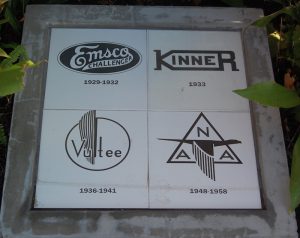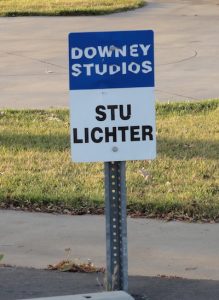 From October 2012 the studios were demolished to make way for a new shopping complex.
From October 2012 the studios were demolished to make way for a new shopping complex.
See Curbed LA postings about the development.
An article (http://www.presstelegram.com/news/ci_19802192) from 2012 states that the studios lost $13 million in the last seven years and cannot continue to trade.
A large portion of this must relate to the controversy over health issues at the former NASA plant (see Chronology below).
By April 2013, the site had been completely cleared. The admin buildings remaining from the Vultee days were still there, but in very poor condition.
In April 2014, there was no significant change on the site – no construction had taken place.
From the official Downey Studios website (2010):
“The Downey Studios is a production studio in Downey, California. The studio features 80 acres (320,000 m2) of indoor and outdoor production space including a 50,000-square-foot (4,600 m2) building and a 250,000 sq/ft building which is home of the largest indoor water tank in North America. A suburban residential street backlot with 5 complete homes and 11 facades is also available at the studio. ”
Address
12214 Lakewood Boulevard, Downey, CA 90242
About the Studio (from the Downey Studios website)
SPACE – OUR PAST AND OUR PRESENT
Downey Studios is situated on the site of a former NASA/Boeing site in Los Angeles County. The site was chosen in 1929 by E.M. Smith so he could build his new aircraft The Challenger. Through the years, the site has been home to numerous ground-breaking and record shattering innovations, including the Navaho Missile project, the Apollo Spacecraft Development program, and the Space Shuttle.
Aerospace history was made here and now we are making Hollywood history. We are the largest independent film facility in Los Angeles. In addition to the biggest undeveloped back lot, we are also home of the largest indoor water tank in North America. And we offer all the amenities of a full service major studio with none of the hassles. All of this lies in the 30 mile zone and is an easy drive from anywhere.
Downey Studios is managed by Industrial Realty Group.
With a privately held and managed portfolio in excess of 40,000,000 square feet, Industrial Realty Group, LLC is among the country’s largest private owners of commercial and industrial properties.
IRG, a Los Angeles-based company, owns and operates more than 60 major developments in 25 states. Management offices are located in Los Angeles, Sacramento, Chicago, Akron, Detroit, and New York.
IRG is recognized as a leading force behind the adaptive reuse of closed buildings and facilities throughout the nation. Retrofitting otherwise obsolete buildings, corporate campuses, and industrial complexes are among the company’s core competencies. IRG is recognized for its success in converting brownfield sites, including NPL Superfund Sites, to productive new uses.
IRG is a leader in the conversion and privatization of federal properties, including closed military bases. IRG owns or is master developing three closed military bases and a closed Veterans Affairs complex.
Stage 1 (from the former Downey Studios website)
Stage 1 – approx 240,000 sqft Stage
(side with lake)
* 500 x 500 with only ONE set of columns
* 35′ – 45′ Grid Height (up to 35′ high entry doors)
* Catwalk Systems + Grid
* 6400 amps of 480 volt power available
* 60,000 sqft (5′-10′ deep) – 3.5 million gallon indoor wet/dry lake, excavated for Lemony Snicket’s A Series of Unfortunate Events in 2004.
From former Downey Studios website:
65,000 Sq. Ft. Indoor Water Tank, 6 Million Gallons.
20′ – 45′ Ceiling Heights, 35′ Entry Doors, Catwalk Systems, Adjacent Mill Space and Support Space, 6400 Amps of 480 Voltage Power, T-1 Voice and Data communications throughout the building.
Downey Studios Stage 1 Plan (2005) (PDF, from 2005)
Bldg. 290 – approx 50,000 sqft Stage
* 63′ Ceiling Height (up to 60′ high entry doors)
* 110′ wide x 410′ long
* 1600 amps of 480 volt power available
* 1 x 15 ton overhead crane & 1 x 10 ton overhead crane
From former Downey Studios website:
Dimensions; 450’x120′
Concrete Floor, 48′ – 62′ Ceiling Height, 35′ High Entry Doors
1600 Amps of 480 Voltage, Two Story Office Space, T-1 Voice and Data Communications Throughout the building.
(1) 15-Ton Crane/Hoists
(1) 10-Ton Crane/Hoists
60’x30’x17′ Deep Concrete Pit
Ever wonder where the first Space Shuttle was built?
Right here in the space of the building. the first four Space Shuttles were built here and you can film your TV, commercials and movies right here where history was made.
Water Tank
From former Downey Studios website:
65,000 Square Foot Indoor Concrete Lake
Holds approximately 6 Million gallons of water. Great for any type of lake type filming, day or night, wet or dry.
Depths range from 5 – 10 feet.
More Information
Health Issues at Downey
Admin Buildings
Office Buildings from the aerospace plant, used as administrative offices for Downey Studios
Backlot
The studio buildings were backed by a huge backlot area, most of which was ungraded, and included former runways and previously demolished building foundations. At the time of the studio’s closing, the only permanent sets on the backlot were a small suburban street, which was showing signs of age and disuse, which was built for Christmas with the Kranks.
Seen on Screen: Downey Studios [Suburban]
| Title | Released | Director | IMDB |
|---|---|---|---|
| Christmas with the Kranks [Feature Film] | 2004 | Joe Roth |  |
| The Suburban Street set on the backlot was built for this movie, on vacant land to the east of Building 39. | |||
| Jonas Brothers: Paranoid [Music Video] | 2009 | Emmett Malloy and Brendan Malloy | |
| Stage 1 and Suburban Street | |||
| Hormel Foods [Commercial] | 2010 | ||
| Shot on Suburban Street. | |||
Productions shot at Downey Studios
Feature Film (31) | |||
| Title | Released | Director | IMDB |
|---|---|---|---|
| Iron Man 2 | 2010 | Jon Favreau |  |
| Monaco GP scenes were shot on the parking lot at the front of the studio, surrounded by large green screens | |||
| Couples Retreat | 2009 | Peter Billingsley |  |
| Exteriors: night of resort & lagoons | |||
| GI Joe: The Rise of Cobra | 2009 | Stephen Sommers |  |
| Cloverfield | 2008 | Matt Reeves |  |
| Indiana Jones and the Kingdom of the Crystal Skull | 2008 | Steven Spielberg |  |
| Iron Man | 2008 | Jon Favreau |  |
| Pineapple Express | 2008 | David Gordon Green |  |
| The Day The Earth Stood Still | 2008 | Scott Derrickson |  |
| The No Sit List (aka Babysitters Beware) | 2008 | Douglas Horn |  |
| Charlie Wilson's War | 2007 | Mike Nichols |  |
| Helicopter sequences shot at Downey Studios | |||
| Zodiac | 2007 | David Fincher |  |
| Deja Vu | 2006 | Tony Scott |  |
| Santa Clause 3: The Escape Clause, The | 2006 | Michael Lembeck |  |
| The entire production was shot at Downey Studios, including the Elf Village, as well as production offices, classrooms and other support services for the large child cast. | |||
| Smokin' Aces | 2006 | Joe Carnahan |  |
| The Prestige | 2006 | Christopher Nolan |  |
| Island, The | 2005 | Michael Bay |  |
| Slaughterhouse Massacre, The | 2005 | Paul Gagné |  |
| Christmas with the Kranks | 2004 | Joe Roth |  |
| The Suburban Street set on the backlot was built for this movie, on vacant land to the east of Building 39. | |||
| In Enemy Hands | 2004 | Tony Giglio |  |
| Lemony Snicket's A Series of Unfortunate Events | 2004 | Brad Silberling |  |
| Building 1 - the large water tank in this building was excavated for this movie. | |||
| Taxi | 2004 | Tim Story |  |
| Van Helsing | 2004 | Stephen Sommers |  |
| Daredevil | 2003 | Mark Steven Johnson |  |
| Terminator 3: Rise of the Machines | 2003 | Jonathan Mostow |  |
| The Italian Job | 2003 | F. Gary Gray |  |
| Catch Me If You Can | 2002 | Steven Spielberg |  |
| FBI headquarters building. | |||
| Clockstoppers | 2002 | Jonathan Frakes |  |
| Spider-Man | 2002 | Sam Raimi |  |
| Space Cowboys | 2000 | Clint Eastwood |  |
| Life | 1999 | Ted Demme |  |
| Can't Hardly Wait | 1998 | Harry Elfont, Deborah Kaplan |  |
TV Series (5) | |||
| Title | Released | Creator / Showrunner | IMDB |
| Top Gear (US) | 2008 |  | |
| Yo Gabba Gabba | 2007-2020 | Christian Jacobs, Scott Schultz |  |
| Smash Lab | 2007-2008 |  | |
| Big Love | 2006- |  | |
| Monk | 2002-2009 | Various |  |
| Mr Monk Goes Home Again episode - Season 4 episode 2 | |||
Commercial (4) | |||
| Title | Released | Director | IMDB |
| BMW Z4 | 2010 | ||
| Stage 1 - shot in the lake tank. | |||
| Hormel Foods | 2010 | ||
| Shot on Suburban Street. | |||
| Nike Pro Combat Alter Ego | 2010 | Adrian Peterson | |
| Stage 1 - the side without the lake is bigger than a football field. | |||
| Sony Ad - Taylor Swift / Cyber-shot TX7 | 2010 | ||
| Shot in Studio 1. | |||
Music Video (2) | |||
| Title | Released | Director | IMDB |
| Natasha Bedingfield: Touch | 2010 | Rich Lee | |
| Building 11. The video was filmed using a Canon 7D Digital SLR shooting the rear of a Kodak Land camera. | |||
| Jonas Brothers: Paranoid | 2009 | Emmett Malloy and Brendan Malloy | |
| Stage 1 and Suburban Street | |||
Chronology of Downey Studios

One of a series of commemorative plaques at Downey Landing shopping area, adjacent to the studios, 2010 (c) theStudioTour.com
1929: Wealthy industrialist E.M.Smith purchased a 73 acre parcel from James Hughan, who farmed oranges and castor beans on the site. Smith’s EMSCO company had a division called Albatross, which manufactured small aircraft. In addition to manufacturing aircraft, Smith saw the former farm land in Downey as a perfect landing field. The oldest buildings on the Downey Site were built in 1929 to support the aircraft manufacturing effort.
1932: With the Great Depression lagging and poor sales, EMSCO leased the site to Champion Aircraft Corporation who manufactured small, inexpensive 2 seaters meant to fly at low altitudes and low (as little as 10 mph) speeds. Seven months later, Champion also left the site due to poor sales, and the site was leased to Security National Aircraft Corporation. Security was owned by Walter Kinner, who designed and built 2 planes for Amelia Earhart.
1936: Ownership continued to change hands and in 1936, Aviation Manufacturing Corporation moved their Vultee Aircraft Division into the Downey Site at the suggestion of Gerard Vultee, who once worked for EMSCO as their chief design engineer. Vultee primarily manufactured large military aircraft and sold planes to the governments of China, the Soviet Union, Turkey and Brazil.
1938: Vultee was working on a contract with the United States government and was flying back from Washington DC when he and his wife were killed in a plane crash.
1940s: The company forged on without him, and in the 1940s, the Army Air Corp awarded Vultee Aircraft a contract to make their training planes, the Vultee Valiant Basic Trainer. The contract was the largest order ever placed by the Army Air Corp. In need of additional space, LA Architect Gordon B. Kaufman designed space which would double Downey’s size.
1941: Then came World War II and security at the plant was increased. In addition to the anti-aircraft gun which was mounted on the roof, the entire plant was camouflaged to blend in with the surrounding farmland. By 1941, the plant’s output represented 15% of all the military aircraft produced in the U.S. and boasted the first powered assembly line in the aircraft industry. Among many different types of aircraft, Vultee produced the largest number of heavy bombers (B-24 Liberators) in the country.
1950s / 60s: After the conclusion of the War, Vultee was awarded a contract to study long-range missile weapons systems. In the 1950’s and 60’s the site was officially known as AFP16 (Air Force Plant 16) and was working on developing the Navaho Missile, whose technology would give birth to our first space vehicles. In addition to all the innovation in technology, there were also many mergers and consolidations in the industry. Vultee gave way to Convair which became North American Aviation, which merged with Rockwell Standard and finally North American Rockwell Corporation.
Late 1950s: The plant became the location for developing the Hound Dog AGM Missile, which was the prototype for cruise missile technology. The company also won the contract to make the Little Joe Launch Vehicle to test the Mercury capsules.
1960: The company was working on the development of the X-15 aircraft, truly a pioneer in aviation history. The X-15 aircraft was the first winged craft to reach 4, 5 and 6 times the speed of sound, and fly at altitudes greater than 100,000 feet.
1961: The company was awarded 2 contracts from NASA: the Saturn SII launch vehicle and the Project Apollo Spacecraft Development program. With that, Downey became the hub of America’s lunar mission.
1964: The AFP16 facility was transferred to NASA, and was now known as NASA Industrial Plant, Downey.
1972: In July 1972, at the end of the Apollo program, Downey was given the job of assembly and component manufacture of the Space Shuttle Orbiters. Over the course of the next 13 years, 4 Space Shuttle Orbiters (Columbia, Challenger, Discovery and Atlantis) were constructed at Downey. The Endeavor, which replaced the Challenger, was also manufactured at Downey. Downey would also be involved in the Skylab project.
1990s: During the 1990’s, the workforce at Downey was decreased.
1996: Rockwell was bought out by Boeing North America. Boeing began consolidating its operations and announced that it would close the Downey plant permanently by the end of 1999.
1999: The city of Downey drafts plans for a shopping center, hospital and movie studio on the 160 acre site, and buys an initial 66 acres from the federal government.
Environmental surveys documented extensive contamination. Trichloroethylene was found in high concentrations in soil and groundwater. Exposure to elevated levels of the industrial solvent can cause nerve and organ damage, respiratory problems and impaired immunity.
Hexavalent chromium, used to plate metal and rust-proof aircraft engine parts, was also found in high concentrations in the soil in places. Exposure to hexavalent chromium can cause cold-like symptoms and damage to the nose, throat and lungs. Direct contact with the skin can cause rashes and sores.
2003: Industrial Realty Group takes over management of the site and in November buys around 60 acres and leases an additional 20 from the City of Downey. IRG still operated the studios until their closure.
August 2003: A city inspector came upon a pile of dirt excavated from beneath the main studio building, called Building 1, to create an artificial lake for Lemony Snicket’s A Series of Unfortunate Events. (The reservoir served as Lake Lachrymose in the film.) The inspector noticed patches of yellow-green soil in the pile, a possible sign of chromium contamination, according to records of the Los Angeles Regional Water Quality Control Board. The city halted all work at the site and had the soil tested. In some samples, measurements of total chromium — a combination of hexavalent chromium and trivalent chromium — were far above the federal safety standard, water board records show. The records say the chromium may have been discharged during the 1950s when a section of the building was used as a plating room.
November 2003 – January 2004: Cleanup crews separated the contaminated soil from clean soil and deposited it in a pile to be disposed of later off-site. During this process, an industrial hygienist monitored chromium levels in the air and found that they were safe, according to water board records. The pile of contaminated soil eventually grew to nearly 7,000 tons.
Feb 2 – Feb 10 2004: The contaminated soil is moved to a landfill site in Lancaster.
2004/2005: Downey Landing shopping area constructed, replacing a portion of the site. Commemorative plaques surround the parking area (see gallery below)

Car Parking spot for Stuart Lichter, IRG (April 2013)
2004: Construction was underway in Building 1 of futuristic sets for The Island. The hangar was still being renovated and the roof was not water-tight, leading to mold growing on the walls. Some crew members developed respiratory problems.
2005: Unions and regulatory authorities become aware of health issues at Downey Studios.
2008: Stories appear in the press about a strange respiratory sickness, dubbed the ‘Downey Flu’ which is affecting crew members working at the studio. Despite a thorough cleanup following the years of aerospace work on the site (working with many toxic materials) many crew members have reported strange symptoms.
To date, no compensation claim has been successful against the studio and the film-workers union IATSE has reassessed the buildings at Downey Studios and found them to be a safe and healthy environment.
See LA Times article for more details
November 7 2008: A fire damaged the studio. The fire appeared to have been caused by an exploding propane tank on the backlot. Two Apollo space capsules were threatened by the fire (which were waiting to be installed at the nearby space museum). Fire fighters from Downey, Santa Fe Springs and LA County responded.
August 2009: Press conference in LA about the Downey toxic dump health issues.
October 2012: The studio complex and all remaining industrial buildings are demolished to make way for a new retail, office and entertainment complex, Promenade at Downey, to be developed by IRG (who also developed the Downey Studios project). .
 2013: The site is now completely cleared of studio buildings, apart from the admin offices nearest Lakewood Blvd (remaining from the NASA days)
2013: The site is now completely cleared of studio buildings, apart from the admin offices nearest Lakewood Blvd (remaining from the NASA days)
2016: The final parts of the Promenade at Downey is completed by Industrial Realty Group.
IRG website article
The work of the Downey site towards the space and aeronautical industries is commemorated at the Columbia Memorial Space Center, near the former studio site.

































